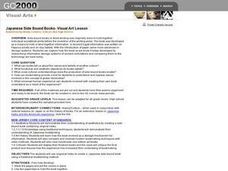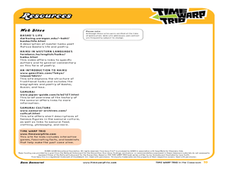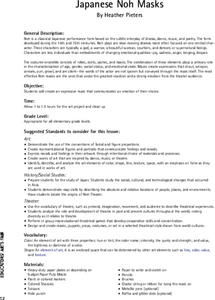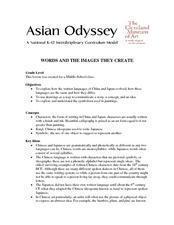Curated OER
The Art and History of Japanese Calligraphy
Chinese and Japanese calligraphy is beautiful and significant in both culture and tradition. Engage your class in this expressive fine art form through a lesson on using, holding, and creating brush strokes common to Japanese writing...
Curated OER
Being in the Noh: An Introduction to Japanese Noh Plays
Students read a Japanese Noh play and discuss its structure and traditional characters. They choose a short myth and write a Noh play based on it.
Curated OER
Lesson: Creating With A Purpose
Discovering the creative process can be done through critical analysis. Upper graders examine a hand -carved Shinto Deity, discussing purpose, technique, and artistic expression. They then read a poem about the creative process. and...
Curated OER
The Poetry of Chinoiserie
Students study Asian works of art and Japanese haiku. They then take this knowledge and create an original haiku in response to other works of art.
Curated OER
Gyotaku Lesson Plan
Learners study the Japanese art of fish painting called Gyotaku while examining the lifestyle of Japanese fishermen at the end of the Edo period. They make a Gyotaku fish print and write a haiku poem using the proper number of syllables...
Curated OER
Under the Blood-Red Sun
Fifth graders explore U.S. history by reading an award winning book about World War II. In this Japanese internment camp lesson, 5th graders read the book Under the Blood-Red Sun and discuss the entrapment of Japanese-Americans on our...
Curated OER
World War II: Internment in Hawaii
Students examine world history by writing an essay in class. In this World War II lesson, students identify the attack on Pearl Harbor, the response from the U.S and the effect it had on Japanese-Americans. Students define Japanese...
Curated OER
The Poetry Of Chinoiserie
Students examine works of art that incorporate Asian export objects, and then respond to them using Japanese haiku poems. discuss the subject and meaning in a work of art. They explain the basic ideas behind Japanese haiku poetry.
Curated OER
Haiku: Observation and Writing in the Japanese Garden
Students observe a Botanical Gardens. Upon returning to the classroom, students write their own Haiku based on their observations.
Curated OER
You Too Can Haiku: How to Write a Haiku
Students explore language arts by writing their own poems. For this haiku lesson, students investigate the Japanese culture and their beautiful music, poetry and art. Students count the syllables in every line of a haiku poem and write...
Curated OER
Paper Cranes
Paper folding is a great art form that can be incorporated into cultural, mathematic, and art lessons. This resource includes the full instructions needed to fold a paper crane, as well as a Haiku poetry idea. Tip: This activity would be...
Curated OER
Who Were the Dissidents?
Young scholars discover how Japanese dissidents spoke out against the injustice practiced in Imperial Japan. In this Japanese history lesson, students listen to a lecture about the silent dissidents in the nation prior to World War II...
Curated OER
Being in the Noh: An Introduction to Japanese Noh Plays
Students analyze the conventions used in Noh plays and write an introduction to a Noh play of their own. In this Noh play lesson, students identify the conventions of the Noh form and analyze the realizations the main character achieves....
Curated OER
Langston Hughes: Artist and Historian
Students examine the life and works of Langston Hughes. In groups, they research the characteristics of the Harlem Renaissance and how Hughes' poems relate to the era. They use the themes in his writings and relate it to the Great...
Curated OER
Japanese Side Bound Books
Students create Japanese side-bound books using traditional bookbinding methods and original Haikus in this Art lesson for the High School classroom. The lesson can be modified for any grade level and can be accomplished in two class...
Curated OER
Sam Samurai
Young scholars study the history and culture of 17th century Japan by examining samurai. They review the format of haiku poetry and examine renga poetry. They examine Kamishibai, the Japanese storytelling form and apply it five facts...
Curated OER
Nature and Haiku Poetry
Young scholars compose haiku poems and recognize how cultures value nature and
natural forces through the study of Japanese poetry. This lesson includes a bibliography of resources.
Curated OER
"Open Mic" - Giving Creative Expression To The Connection Between The Japanese American Internment, September 11, And Our Rights Today
Students explore the similarities of the Japanese-American experience in WWII and Arab-American experience in post-September 11 US policy. They create presentations on their reflections and express themselves through poetry, dance,...
Curated OER
Japanese Peasants
Students examine how the Japanese peasant was depicted in art in this high school lesson plan about Asian cultures. Emphasis is placed on individual observations and written reflections.
Curated OER
Japanese Noh Masks
Students examine Japanese theatre and create their own face masks which display certain emotions, props, costumes and perform in improvisational theatrical games.
Curated OER
Concepts of Beauty Put Into Words
Studying haiku poetry with your English class? Delving into Japanese history with your world history class? Here is an authentic and creative way to explore Japanese culture more deeply. Pupils will compare and contrast two tea caddies...
Curated OER
Words And the Images They Create
Students explore how the written languages of China and Japan evolved, creating representations of Chinese and Japanese Poetry. Emphasis is placed on small, cooperative learning groups.
Curated OER
Silent Stories
Young scholars create a pictorial narrative based upon John Keats' "Ode on a Grecian Urn" and the Japanese techniques of "lacquer jar" stories in this three-day Language Arts/Art lesson.
Curated OER
Shinto, Stones, and the Garden
Students examine how Shinto and Buddhism are reflected in the Japanese art and life-style, especially as seen in the relationship people have with the land (gardens). This lesson is for the elementary classroom.























